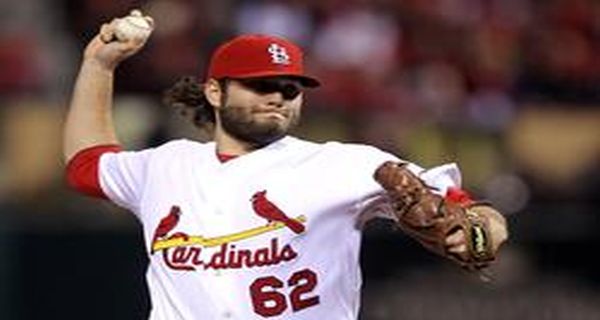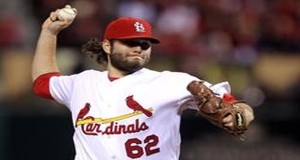First Pitch Strikes as an Indicator for Potential SP Risers and Fallers

Strike one has been the most important factor for pitchers seemingly since the beginning of time. So far in 2013 Major League Baseball pitchers have allowed a .224/.264/.341 slash line after a 0-1 count. Furthermore, pitchers have a strikeout to walk ratio of 6.36 after an 0-1 count. After 1-0 counts, Major League Baseball pitchers have allowed batters to hit .269/.378/.441. Here it is in tabular form:
| Count: | Triple Slash | HR Per PA | BABIP |
| After 0-1 | .224/.264/.341 | 2.09% | .293 |
| After 1-0 | .269/.378/.441 | 2.93% | .299 |
| Batter Ahead | .295/.461/.502 | 3.27% | .298 |
| Even Count | .269/.274/.424 | 3.00% | .298 |
| Pitcher Ahead | .204/.212/.299 | 1.67% | .290 |
The above data from this season makes it clear that getting a first pitch strike, and then expanding on that and being ahead in the count, is paramount to a pitchers’ success. Note that “HR per Plate Appearance” means “what percentage of plate appearances for the qualifying count or situation resulted in a home run”.
There are multiple pitchers this year that are severely at risk to “lose their gains” in strikeout rate and walk rate should their command falter. When analyzing guys like Patrick Corbin, Derek Holland, Lance Lynn, Homer Bailey and Matt Harvey, we are accessing the data we have accrued so far. We are looking at what has gone on “so far” and determining whether it’s legitimate. Specifically in the case of Homer Bailey, his increased ground ball rate which now sits at 50%, his increased strikeout rate, and decreased walk rate have resulted in a 3.04 xFIP to date for the young Cincinnati right hander; making his performance to date “legitimate”.
However, there are some pitchers that struggle more than league average when they are behind in the count. Should their command and mechanics slip even a little bit in the second half of the season, they carry slightly more risk because their peripherals will suffer more. Let’s examine Kris Medlen’s 2012 and 2013 seasons as an example of this.
Medlen went on arguably the greatest 13-start run in the history of Major League Baseball in 2012. During that 13 start run, Medlen posted a 54.7% ground ball rate (the highest of his career by a full 10%), a 27% strikeout rate, and a miniscule 3.2% walk rate. Obviously his strand rate of 93.3% as a starter meant that his 0.97 ERA over the 83.2 inning span was certainly going up, but his xFIP was 2.50. If Medlen retained those skills in 2013, he would be a bona-fide ace.
I admit I fell into this trap and while I didn’t end up with Medlen on any of my teams because of his high price, I did have him highly ranked in my 2013 starting pitcher rankings (inside the top 20).
Should I have known there was quite a bit of risk in him retaining his level of command and peak mechanics? Yes.
During that magical run, Medlen had only a 20% strikeout rate, whilst recording an 8.7% walk rate after starting the count 1-0. Through 0-1 counts, he recorded a 29.3% strikeout rate and a 2.5% walk rate. Medlen doesn’t have the type of overpowering stuff necessary to come back from a hole of a 1-0 count. The 42 percent ground ball rate version of Kris Medlen can be closely compared to Tommy Milone. ( I distinguish the ground ball rates for Medlen because his 53 percent rate last year was the extra bit of evidence in his skill profile last year that led me to believe he could retain ace level skills).
Milone has an excellent ability to command his pitches and also can go through spurts where he exhibits unbelievable peak mechanics. Milone had a six start run in the middle of 2012 in which he record 36 strikeouts and only three walks in 41 innings. During that six start run, Milone posted an ERA of 1.10 and a WHIP of 1.00. Unfortunately, Milone’s lack of excellent stuff means that he must use his pinpoint command and pitch sequencing to maintain success.
But here now in 2013 for both of them..:
| Milone | Medlen | |
| K% through 0-1 | 27.8% | 23.9% |
| K% through 1-0 | 13.4% | 14.4% |
| BB% through 0-1 | 3.1% | 2.7% |
| BB% through 1-0 | 8.9% | 19.2% |
| ISO allowed (Slugging Minus Batting Average) through 0-1) | .123 | .122 |
| ISO allowed through 1-0 | .265 | .190 |
| xFIP through 0-1 | 2.91 | 3.06 |
| xFIP through 1-0 | 5.25 | 6.25 |
As a counter to this and to show that pure stuff can result in not having an enormous disparity between skills after a first pitch strike, I give you Max Scherzer.
Scherzer has the split just like everyone else, but his is significantly less exaggerated due to his incredible stuff. Scherzer has a 33.9 percent strikeout rate and a 2.9 percent walk rate through 0-1 counts this year, resulting in a 2.05 xFIP. In contrast he has a 3.14 xFIP through 1-0 counts. However, one of the problems with xFIP does arise in this scenario, because it makes sense that a guy would allow more home runs and harder contact through 1-0 counts, and Scherzer’s .190 ISO allowed through 1-0 counts and .063 ISO through 0-1 counts shows that.
Patrick Corbin is a current example of a pitcher who stands to be in for a skills dip should his first pitch strike command falter. Corbin has increased his first pitch strike percentage to 10 percentage points over last season (58.6% to 69.5%). That increase has been one of the biggest reasons he has been so much better this season. Corbin sports a 2.13 FIP and 2.73 xFIP through 0-1 counts compared to a 5.02 FIP and 5.50 xFIP through 1-0 counts. I specifically note the FIP (Fielder Independent Pitcher) for Corbin, because I believe his ability to keep balls in the yard (at a better rate than league average) is real, and xFIP assumes a normalized home run per fly ball rate. If Corbin’s first pitch strike percentage dips a bit though, his home runs could skyrocket, thanks to a .169 ISO against through 1-0 counts. Should he maintain his first pitch strike percentage though, his .071 ISO against through 0-1 counts should shine through and keep his home runs and ultimately his ERA down.
We finish with a table displaying pitchers more likely to experience skills regression thanks to massive 0-1 and 1-0 splits (since pitchers can’t retain peak mechanics forever).
| Player | K% ; 0-1 | K%;1-0 | BB%; 0-1 | BB% ; 1-0 | xFIP ; 0-1 | xFIP; 1-0 |
| Justin Masterson | 34.3% | 15.8% | 4.6% | 18.4% | 1.92 | 5.64 |
| Lance Lynn | 36.7% | 14.0% | 3.9% | 19.3% | 1.93 | 6.03 |
| Jon Lester | 25.5% | 16.1% | 6.5% | 13.6% | 3.11 | 5.21 |
| Derek Holland | 31.0% | 17.0% | 2.7% | 12.6% | 1.87 | 4.94 |
| Homer Bailey | 35.0% | 17.4% | 3.9% | 13.0% | 1.84 | 4.48 |
| Jeff Samardzija | 38.2% | 23.9% | 4.1% | 15.9% | 1.74 | 4.20 |
| Mat Latos | 30.5% | 15.9% | 3.5% | 12.1% | 2.29 | 4.76 |
| Matt Harvey | 36.1% | 20.8% | 1.6% | 12.8% | 1.64 | 4.49 |
| Player | ISO against 0-1 | ISO against 1-0 |
| Justin Masterson | .069 | .124 |
| Lance Lynn | .087 | .162 |
| Jon Lester | .130 | .166 |
| Derek Holland | .097 | .091 |
| Homer Bailey | .088 | .115 |
| Jeff Samardzija | .101 | .103 |
| Mat Latos | .121 | .148 |
| Matt Harvey | .033 | .128 |
These players, more so than some of their counterparts, carry the biggest risk this season should their command slip (especially on the first pitch).






